Speed 6.4 knots (kts) Course 28° Location Northern Canada Basin, 80.93° N, 136.79° W Depth 3780 meters
SPECIAL FEATURE DISCUSSION:
(see previous journal for the questions.)
Strong earthquakes can produce damaging seismic waves. But earthquakes also give us an insight into the internal structure of the Earth. Earthquake-generated seismic waves can pass through or be absorbed by different layers deep inside the Earth. By analyzing patterns of waves received at seismic stations around the world after earthquakes we can measure the thicknesses of the crust, asthenosphere, mantle, outer core, and inner core.
Scientists also use core sampling and drilling to find out what is beneath the sea floor. While core sampling can recover samples from many meters under the sea floor, drilling can reach thousands of meters beneath the sea floor. Drilling is very expensive, though, and most commonly used in the oil and gas industry.
TODAY'S JOURNAL:
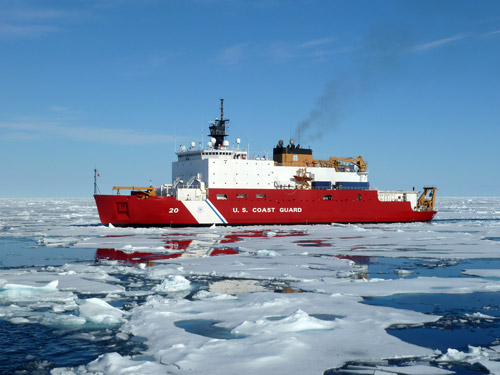
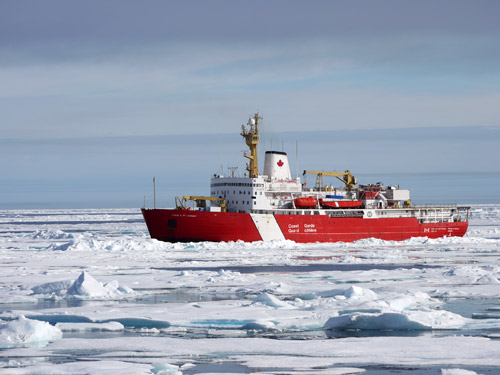
On a quick status update, we've crossed over the 80° N latitude line and find ourselves in the most extensive and substantial sea ice yet. Much of what we are going through is multi-year ice. We are traveling alone for now as the Louis stopped to make repairs to one of their propeller shaft bearings. We are pushing ahead a bit to do some further studies on a seamount discovered on last year's cruise. From there we'll await updates from the Louis before planning the next objectives. If I don't have a journal update or respond to Ask The Team questions in the upcoming days it will be because we've gone north of our communication satellite's range. We don't anticipate this happening but it is a possibility I thought I'd mention.
When I visited the Louis S. St. Laurent the other day I found it interesting to make comparisons to the Healy. Both are very large ships, with the Healy 420 feet long and the Louis at 393 feet long. The Healy weighs around 16,000 tons to Louis' 13,000 or so. When walking around the Louis it felt a little more compact and snug. They have 72 folks on board compared to our 112. I liked the stairs on the Louis that felt more like those at home or school compared to the steep metal ladders on the Healy. It was also interesting that the passages and rooms on the Louis had normal-looking ceilings. On the Healy there are exposed pipes and wires everywhere you go on the high ceilings. It seems like to go anywhere inside the Healy there are a lot more watertight doors to open and close and it takes longer to get anywhere. The Louis has several dining areas- the Captain's dining room where on Sundays a formal dinner is served, a crew cafeteria including an engineers' room where workers in coveralls can eat without changing cloths, and an officer's dining room. On the Healy there is one big dining area though it is divided in two halves, the port mess and starboard mess. In between is the galley where food and beverages are prepared and served.
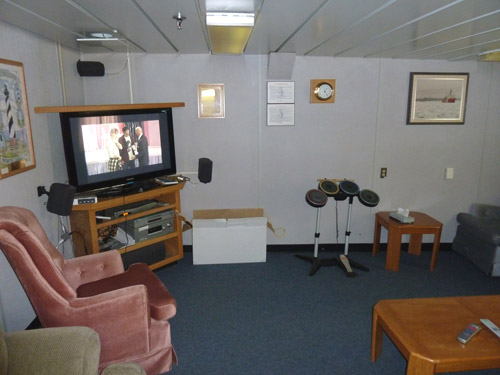
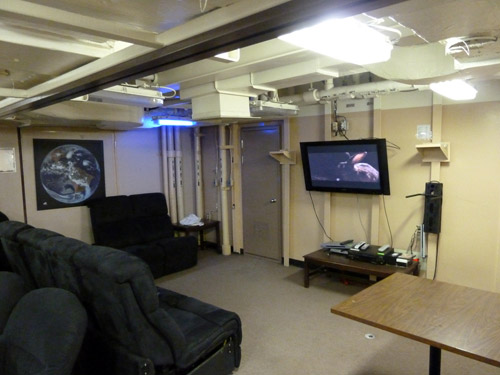
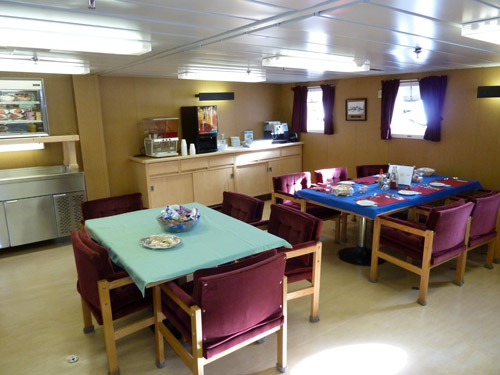
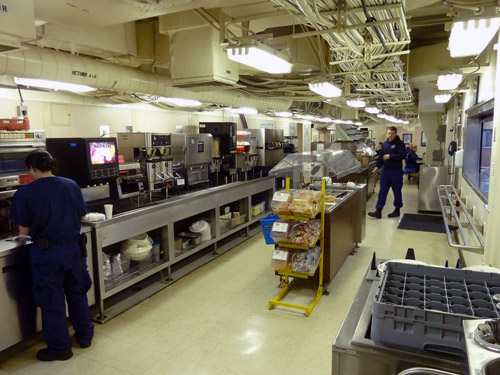
The bridge of the Louis was a little smaller and brighter with white paint and lower ceilings. Ours is dark with a black floor, ceiling, and fixtures. The bridge windows on the Louis are flat, all along a gentle curve looking forward while those on the Healy's bridge angle downward and have sections wrapping around the sides and back of the bridge. A quartermaster sits front and center on the Louis' bridge, steering the ship with a wheel. On the Healy the ship is usually controlled by officers on the port side from a bank of instruments. A small steering wheel located towards the back of the bridge is rarely used. If I had to sum it up in one sentence I'd say the Louis feels more classic or traditional while the Healy feels more military. (Keep in mind I have virtually no prior experience on large ships, though!)
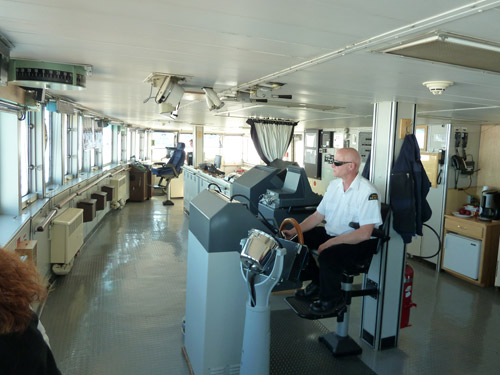
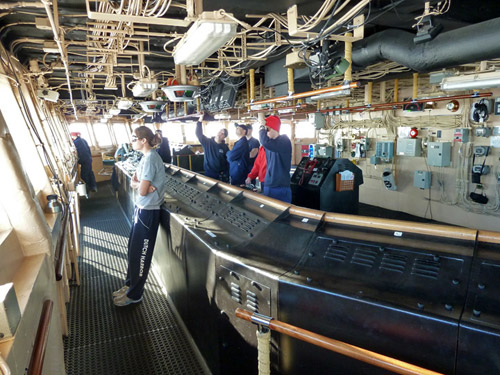
On most places around the Louis it was louder than I'm used to on the Healy because of air compressors. The Louis uses a bubbler system at the bow that blows massive volumes of air under water along each side of the bow as it is breaking ice. When on or near the bow you hear the massive compressor powering the bubbler system. It helps by getting air under the ice, floating it up to make it easier for the hull to push aside. It also wets the surface of the ice, making it more slippery to ease passage of the ship. It seems to me that the Louis leaves a cleaner wake through the ice than we do. When the Louis is trailing Healy and you look back, the bubbler system has the odd effect of making the ship look like it is going fast through the water, throwing out a bow wave on each side. Towards the stern you hear the compressor system providing air to the pneumatic sound source array. Every 17 seconds or so you can hear and feel the air generated pulses of acoustic energy while the system is running.
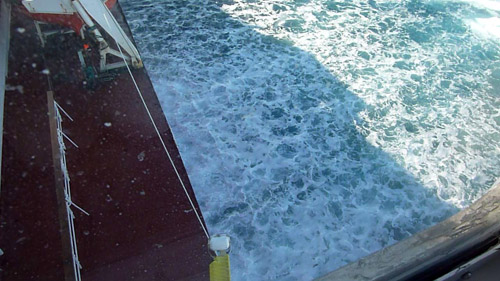
The Louis was built in 1969 with the Healy coming out of the shipyard about 30 years later. It has a narrower hull with a more traditional u-shaped profile than the Healy's flat-bottomed hull. Many experienced sea-goers on this cruise have commented on how steady the ride of the Healy is. The Louis has more curving lines while the Healy looks a bit more boxy. The Louis has three propellers and a single rudder while the Healy has two propellers and two rudders. Both ships have electric propulsion motors with diesel engines connected to generators to produce the ships' power. As icebreakers they have protected rudders and special propellers. They have a higher power-to-size ratio than found in typical ships, and feature improvements like tighter framing and thicker hulls, particularly in the bow and stern areas. They also have special paint that resists ice abrasion and lowers friction. IcebreakerAn icebreaker is a special purpose ship or boat designed to move and navigate through ice-covered waters. bows are designed so in thick ice the ship will ride up onto the ice until their weight breaks them through.
SPECIAL FEATURE:
What tricks do you think an icebreaker can try if it gets stopped by the ice?
That's all for now! Best- Bill


Comments